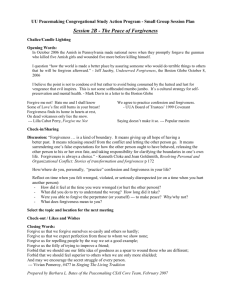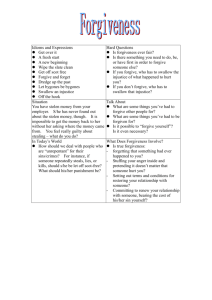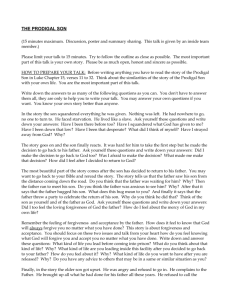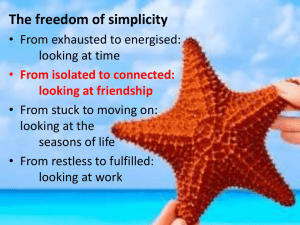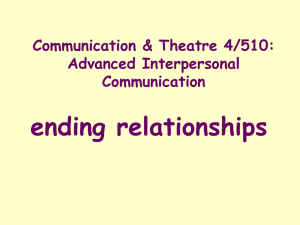Forgiveness - Manna Counseling Service
advertisement
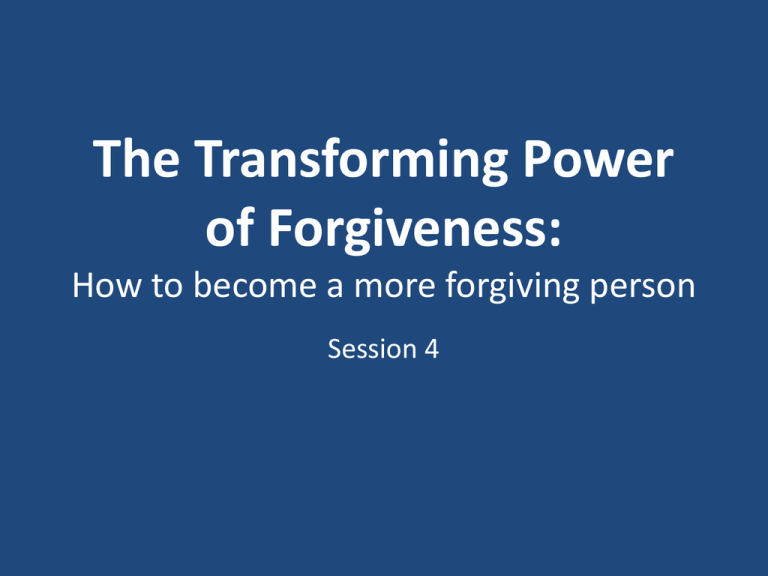
The Transforming Power of Forgiveness: How to become a more forgiving person Session 4 Martin’s E-Mail: manna@iglou.com Review • Session 1 – we looked at the way scriptures portray forgiveness • Session 2 – we looked at two ways to define forgiveness (decisional and emotional). We began to talk about the target hurts we identified in session 1 • Session 3 – we explored those hurts further and began to look at them differently that we may have in the past. At the end of the session we examined how we always seem to have good reason or justifications or at least excuses if we hurt or offend someone. Session 4 Empathy For The One Who Hurt You: The hard part of experiencing emotional forgiveness • Today we will tackle the hard work of experiencing emotional forgiveness. That is, to try to empathize, sympathize, feel compassion for, or even love the one who harmed us. • This is obviously a hard thing to do, but we will experience peace and emotional forgiveness to the degree we are successful doing this. GOALS FOR SESSION 4 1. To empathize with the person who hurt us. 2. To learn ways that we can promote empathy. 3. Even if we cannot empathize, to learn ways to sympathize and experience compassion for those who have harmed us—and ultimately to love our enemies. Worthington, E. (1997). Promoting Forgiveness in Clinical Practice. AACC World Conference on Christian Counseling Thought Questions for Session 4 1. How can we discern God’s heart? Isn’t God hard to identify with? 2. Does God really want us to get into the mind and heart of a person who inflicted harm on us? 3. In empathizing, loving our enemies, and forgiving, what is our part and what is God’s part? Remember: We Do Things For Reasons • The previous session, you thought of a time when you hurt someone. We concluded this: • We all do things for what we believe at the time to be good reasons. Sometimes, though, we hurt instead. Because we have all had this experience of hurting others even with the best of intentions, we can understand that the person who hurt us probably (possibly?) had what he or she believed to be good reasons. That person might not be as mean or evil or uncaring as we thought. • You have thought about this since the previous session. Do you still believe this idea has merit? Why? Empathize Empathy involves seeing things from another person's point of view, feeling that person's feelings, and identifying with the pressures that made the person hurt you. How would he or she explain the harmful acts? http://mailer.fsu.edu/~cfigley/Research/forgiveness.html Victim No Longer! Forgiveness is facilitated when we can look at the transgression from multiple perspectives. The harmful act is seen more objectively when we can step outside of the victim role. We have a chance to view what happened from a bigger perspective – one that includes the human and the divine. Trying To Understand The Person Who Hurt You Pertaining to the target transgression: 1. Talk with your dyad partner about what you think your offender was experiencing. 2. Ask the dyad partner for other possible experiences the perpetrator might have had. 3. Switch and the dyad partner talks, followed by your feedback. Empty Chair Exercise • Done with your partner. • Both do the exercise, but only one at a time. • While the active partner works through the exercise, the observer is supportive, but silent. • We will pretend the transgressor is in the empty chair. • First, tell the transgressor how you were hurt by them. • Second, move to the empty chair and pretend you are the transgressor. Talk from their point of view, what you saw, thought, heard, felt. • Then move back into your first chair and be “you” again. • Keep moving back and forth having a conversation. • I will tell you when to switch with your partner. Keep the conversation going until I tell you its time to switch. Processing the Experience • Did you consider the person’s history? • Did you consider the pressures that the person is under? • Do you understand the person’s perspective any better? • What are your reactions to having done this? If you are like most… The “Empty Chair” exercise will result in one of two things happening: 1. You come to see things from another’s perspective and become more willing to forgive them. 2. You come to see that regardless of what they say, you don’t need their apology to forgive. You can be autonomous. What if I’m having trouble with this?! • If you are feeling that you really do not want to empathize with the person… Understand that it is indeed difficult to do. • It is the least desirable thing to think about doing. • Most agree that this is the most difficult part of trying to achieve lasting forgiveness. • This is particularly true if you have to keep interacting with the person and if the person has been hurtful more than once. Empathizing With The Heart Of God • We have tried to discern what God would want for you in several contexts in previous sessions. • Consider what God may want for both you and your offender now that you have spent some time thinking about what it might have been like for the offender… Empathizing With The Heart Of God 1. What does God’s heart want for your offender? 2. What does God’s heart want for you? Remember, experiencing emotional forgiveness and peace, depends on your being able to replace negative emotions like bitterness, resentment, hostility, hatred, anger, or fear with positive emotions. You’ve been trying to feel empathy with the person—to understand the person’s reasons for doing what he or she did, to feel with the other person, or even to identify to some degree with the person. That might, if you persist in it, help you experience emotional forgiveness and peace. It’s probably too early to tell, but you are working toward replacing those negative emotions with more positive ones. Moving From E to A… • Empathizing with the transgressor is truly the crucial step. If you can feel true empathy for the person, or true sympathy, or true compassion, or true love, then those positive feelings will gradually eat up the negative feelings of resentment, bitterness, hostility, hatred, anger, and fear of the person who hurt you and will replace any feelings of unforgiveness with feelings of forgiveness. However… Taking that step of replacing the resentments you might have held onto with more positive feelings is something you can do for one of two motivations. 1. You can give up the unforgiving emotions because you know that you will improve your health, your mood, your relationship, or your spiritual life—as we talked about early in the group. You can give up the unforgiving emotions and feel more positive emotions because you will be free of the weight of unforgiveness that makes you angry. Or… 2. You can forgive because you are willing to give an altruistic, unselfish gift of forgiveness to the person who hurt you—because you are willing to give a gift of agape love, like Jesus did with his enemies, to the person who harmed you. It isn’t easy to give an altruistic gift of forgiveness. In fact, it’s one of the hardest things we might be asked to do in this life. The question is… Is forgiveness for-getting or for-giving? People who forgive for unselfish altruistic reasons will actually get more benefit than people who try to consciously get the benefits by forgiving. So apart from any other reason for pursuing altruistic forgiving, it turns out to be a paradox. Perhaps it is simply that God honors those who seek to act unselfishly or without self-interest. Perhaps there is something healing in sacrifice. Whatever the reason, having altruistic motives seems to be healing. Further… It seems more important that one forgive with altruistic motives than that one express that forgiveness to the person. Emotional forgiveness happens within the skin of the forgiver. When we express forgiveness, we are really talking about a different process—the process of reconciliation. A Quick Review… • So Far we have: • Experienced decisional forgiveness as we let go of our grudge. • We have covered Recall of the hurt, and Empathy with the transgressor. • Now we move onto the A part of the REACH model – give and Altruistic gift to the one who hurt you. When Did You Do Something Altruistic For Someone Else? • Altruism is “Other-Regarding” behavior. It’s doing something nice, positive, etc. for someone with the primary motive of helping that person. • Exercise 4-15 – Discuss in dyads a time that you did something altruistic for someone. – What motivated you? – How did you feel about doing it? – How did you feel afterwards? Yehiel Dinur …a holocaust survivor who was a witness during the trial of the Nazi war criminal, Adolf Eichmann. Dinur entered the courtroom and stared the man who had presided over the slaughter of millions. The court was hushed as a victim confronted a butcher of his people. Suddenly Dinur began to sob and collapsed to the floor. But not out of anger or bitterness. As he explained later in an interview, what struck him was a terrifying realization. “I was afraid about myself,” Dinur said. “I saw that I am capable to do this…Exactly like he.” In a moment of chilling clarity, Dinur saw the man as ordinary. “Eichmann, “he concluded, “is in all of us.” So What Do You Think? 1.What is the point of this story? 2.Do you agree with it? 3.Why or why not? Ordinary…??? If we are all capable of doing evil, are we really all that different from the person who has harmed us? Given that fact… Can we be merciful in our judgment of that person? Picture your offender…or yourself here. Matthew 18:21-35 (the Parable of the Unmerciful Servant) Jesus suggests that forgiveness is what forgiven people do! Forgiveness Carol Stratton http://www.marsneedsguitars.com/2007/06/anger.html My anger is too hot. The damage is too deep. There is no food for thought. There is no rest in sleep. You call me to forgive; My heart will not be moved. This is no place to live, But change is hard to choose. http://www.absenceofdistraction.com/images/photo_111.jpg http://thirdwatch.files.wordpress.com/2008/04/forgive.jpg You whisper forgiveness Isn’t forgetting. It’s not condoning, And it’s not defending. When I remember the pain, Then remember the pain I caused You, And how I needed forgiveness I can forgive, too. http://assets.disaboom.com/Images/ConditionSummary/pain.jpg This heart becomes a stone At the mention of that name. The villain stands alone The author of my pain. You call me to accept He’s a person, she’s a person With a need. And I must give to them The gift You’ve given me. http://i121.photobucket.com/albums/o210/luvableariez/prayer.jpg You whisper forgiveness Isn’t forgetting. It’s not condoning, And it’s not defending. When I remember the pain, Then remember the pain I caused You, And how I needed forgiveness, I can forgive, too. http://emergingminister.com/graphics/3crosses.jpg http://www.excerptsofinri.com/images/818fatherforgive.jpg You looked with loving eyes From Calvary’s cross, And You said those words I need to say. I am reminded of the ultimate cost You chose to pay to point the Way. You whisper forgiveness isn’t forgetting. It’s not condoning, and it’s not defending. When I remember the pain, Then remember the pain I caused You, And how I needed forgiveness, And Your gift of forgiveness for all my sin, There is life in forgiveness, So I can forgiveness, too. © 2004 A Stratton Carol http://thirdwatch.files.wordpress.com/2008/04/forgive.jpg What Did You Get Out Of This Session?

